 This review is part of the Cameras of the Dead series which features dead cameras that I’ve wanted to review that either didn’t work, or was otherwise unable to shoot. This April, I will not be doing my usual “Halfway to Halloween” triple-feature, but didn’t want you to think I didn’t have enough dead cameras, so consider this a “Bonus of the Dead”.
This review is part of the Cameras of the Dead series which features dead cameras that I’ve wanted to review that either didn’t work, or was otherwise unable to shoot. This April, I will not be doing my usual “Halfway to Halloween” triple-feature, but didn’t want you to think I didn’t have enough dead cameras, so consider this a “Bonus of the Dead”.
These cameras are the Topcon PR and DeJur Dekon SR, both 35mm single lens reflex cameras made by Tokyo Kogaku in Japan starting in 1960. The DeJur is a name variant of the same camera, exported to the United States by the DeJur Amsco Corporation. Both the DeJur and Topcon are fully mechanical leaf shutter SLRs with a fixed 50mm lens, a fixed pentaprism viewfinder, and no meter. Both models are identical to each other, but there was an earlier Topcon PR that came with a different Citizen shutter and slightly different cosmetics.
Film Type: 135 (35mm)
Lens: 50mm f/2.8 Tokyo Kogaku Topcor/Simlar coated 4-elements in 3-groups
Focus: 2 feet to Infinity
Viewfinder: Fixed SLR Pentaprism
Shutter: Seikosha-SLV Leaf
Speeds: B, 1 – 1/500 seconds
Exposure Meter: None
Battery: None
Flash Mount: Cold Shoe and M and X Flash Sync
Weight: 669 grams
Manual (Topcon PR): http://www.cameramanuals.org/pdf_files/beseler_topcon_pr.pdf
Manual (DeJur Dekon SR): https://www.cameramanuals.org/pdf_files/dejur_dekon_sr.pdf
History
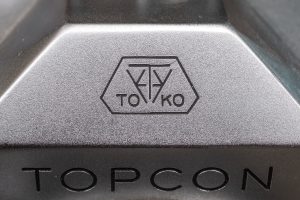 Topcon is a name largely forgotten in photography today as unlike it’s biggest competitors Nikon, Canon, and others, Topcon’s photography division did not survive past the 20th century. At one time though, Topcon made some of the best photographic equipment money could buy.
Topcon is a name largely forgotten in photography today as unlike it’s biggest competitors Nikon, Canon, and others, Topcon’s photography division did not survive past the 20th century. At one time though, Topcon made some of the best photographic equipment money could buy.
Originally formed in 1932 as Tokyo Kogaku Kikai K.K., which translates to Tokyo Optical Company, Ltd, the company was a dependent subsidiary of Hattori Tokei-ten which had a precision manufacturing branch called Seikosha who themselves would eventually be known as Seiko. Tokyo Kogaku would remain a dependent of Seikosha until 1947 at which time would become it’s own entity.
Throughout it’s most prominent years, Tokyo Kogaku would follow a very similar path to Nippon Kogaku (who would later become Nikon). Tokyo Kogaku was originally established as an optics company who was the sole supplier of optics equipment to the Imperial Japanese Army. Nippon Kogaku was the primary optics supplier to the Japanese Navy making the two companies the foremost Japanese optics companies prior to World War II.
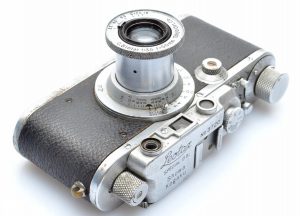
Also like Nippon Kogaku, Tokyo Kogaku would start developing lenses, scopes, binoculars, and other equipment for the military, and would also be a third party supplier to other companies but wouldn’t market it’s products directly to the public, at least not at first. It’s earliest products were three and four element lenses known as the State, Toko, and Simlar. After World War II, the company would branch out to lenses using the Leica Thread Mount for Leotax cameras.
Unlike Nippon Kogaku however, whose first attempt at their own camera was the hugely successful Nikon S rangefinder from 1948, Tokyo Kogaku’s first attempt was far less successful. In 1937, a camera called the Lord was released, a solid bodied 6×4.5 medium format rangefinder with a collapsible lens. It is estimated that only 50 were ever made between 1937 and 1938 and that production was halted due to an outbreak of war between Japan and China. Some historians believe this to be only part of the reason, as the Lord was known to be poorly built and unreliable. This 1937 Lord camera should not be confused with another Lord series of cameras made in the mid 1950s by Okaya Kogaku who was also a child company of Seikosha. Apparently, they liked the name “Lord” so it was re-used on this completely unrelated camera.
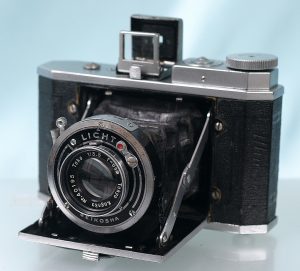
The only other camera made by Tokyo Kogaku prior to the war was the Minion, a horizontally folding strut camera that took 4cm x 5cm images on 127 film. The Minion was much more successful than the Lord as it was made until 1943 and then again shortly after the war.
After Word War II, Tokyo Kogaku would release a 35mm version of the Minion called the Minion 35, and a 6×6 TLR called the Topcoflex. The Topcoflex would be the first time the letters “TOPCO” would be used in any products made by the company, hinting at their eventual change to Topcon.
During my research for this model, I could not find a lot of information about the success of these early cameras, but based on how little info there is, I have to guess they probably weren’t that successful. It is likely that like Nippon Kogaku, Tokyo Kogaku focused most of it’s effort on supplying the Japanese military, but as a result of the de-militarization of Japan after their surrender in the war, the company was forced to grow its portfolio into consumer oriented goods.

In 1957, Tokyo Kogaku would enter into the world of 35mm SLRs with the Topcon R, a high quality camera aimed at the professional photographer. The Topcon R was released two years before the Nikon F and had an interchangeable bayonet lens mount, interchangeable viewfinders, an instant return mirror, support for lenses with automatic diaphragms, and a focal plane shutter with a top 1/1000 shutter speed. Although a very rugged and capable camera, the Topcon R was also very expensive. With an Auto-Topcor 58mm f/1.8 lens, the Topcon R sold for $295 which when adjusted for inflation, compares to about $2650 today, well outside the reach of the average photographer.
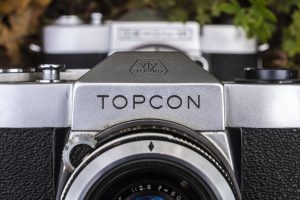
Two years later, in 1959, the company would release a much more economical model, which they called the Topcon PR. The new camera was a much smaller and simpler 35mm SLR with a fixed Topcor 50mm f/2.8 lens, a fixed pentaprism, a Citizen-MV leaf shutter with speeds up to 1/500, and not much else. The camera would compete with other leaf shutter SLRs like the Japanese Kowaflex and German Contaflex SLRs that also used leaf shutters in a fixed lens design.
In 1960, the camera was changed, replacing the Citizen shutter with a Seikosha-SLV shutter, adding a top plate exposure counter, an LV scale on the bottom of the aperture ring, and changing to the modern arrangement of shutter speeds. The revised camera is unofficially referred to as the Topcon PR II, but this name never appeared on the camera, or in any of it’s documentation.
As was the case with the more expensive Topcon R, the camera was not exported into the United States using the Topcon name, instead, the camera was sold by the DeJur-Amsco Corporation in New York City. DeJur was primarily known as a distributor of cinema and developing equipment, but also sold cameras made by companies like Tokyo Kogaku, Petri, and others.
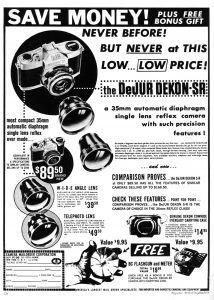
When it was exported to the United States, the DeJur Dekon SR sold for $89.50 for the camera by itself. You could add on accessory screw on wide angle and telephoto lenses, or a leather case for an additional $39.50, $49.50, and $14.95 respectively. When adjusted for inflation, these prices compare today to $790, $350, $435, and $130 respectively.
The ad to the right points out that you could get other cameras with the same features, but not at the Dekon’s low, low price which was true, but other than a value proposition, the camera was pretty simple, not offering any sort of metering, or advanced features which were starting to become common in the early 1960s.
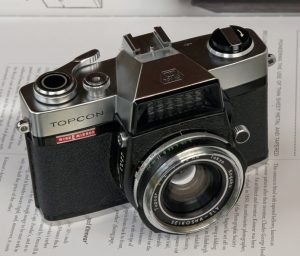
Tokyo Kogaku would quickly replace both the Topcon PR and DeJur Dekon SR in their line up with a more advanced camera called the Topcon Wink Mirror/Beseler Topconette, which added a coupled selenium exposure meter and an instant return mirror that wasn’t common with leaf shutter SLRs.
Tokyo Kogaku would continue with a dual lineup of economic leaf shutter SLRs and more expensive focal plane SLRs throughout the rest of the 1960s. The Topcon RE line-up would be quite successful, at one time gaining the favor of the US Navy.
Although Topcon SLRs were generally well regarded for durability and excellent optics, the company’s reluctance to modernize it’s designs and adopt new technologies caused them to stumble by the late 1960s, and by the 1970s, produced lower end cameras with a poor reputation for reliability. The last Topcon camera was made in 1980, after which time, the company exited the consumer photography business.
Topcon still exists today as a maker of specialist optical equipment not directly related to photography, and in 1989 would change it’s name to K.K. Topcon, the name it still has today. A visit to Topcon’s 2021 products website, lists applications for Global Positioning Systems (GPS) and Eye Care industries.
Today, Topcon’s focal plane cameras are highly sought after, especially their lenses. Some collectors say the Auto Topcor 58mm f/1.4 lens for the RE Super is the sharpest standard prime lens ever made. This reputation generally does not apply to their leaf shutter SLRs, however. Although cameras like the Topcon PR and DeJur Dekon SR are attractive cameras that when found working should be capable of decent images, their poor reputation for reliability and low numbers make them unappealing to most collectors.
My Thoughts
Another leaf shutter SLR, and another Camera of the Dead. You’d think I would have learned my lesson by now.
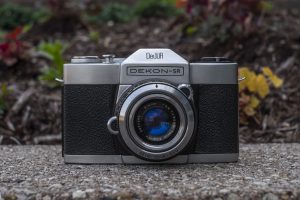
The appeal for me with leaf shutter SLRs is that a large percentage of them are from German companies, and the few that come from Japanese companies have distinct features or designs that you don’t typically see with focal plane shutters. From a collector’s standpoint, focal plane shutter SLRs almost all follow the same formula. Kamera-Werke Niedersedlitz (KW) first set the bar with the release of the Praktiflex and Praktina, but by the late 1950s, Japanese companies like Asahi Optical, Minolta, and Nippon Kogaku solidified exactly how a focal plane shutter SLR should look and work.
This didn’t seem to happen with leaf shutter SLRs as there is a huge variety in the look of these cameras and how they work. Many leaf shutter cameras are more compact than competing focal plane shutter cameras. Cameras like the Voigtländer Bessamatic and Kowa SET-R have smaller external dimensions than SLRs of the same period.

In the case of the Topcon PR and the DeJur Dekon SR, these cameras are some of the smallest full frame SLRs ever made. Compared to a Pentax ME Super, which is another very compact SLR, the Topcon is about 2mm narrower, identical in height (the shoulders of the Topcon are higher, but the overall pentaprism of the Pentax is much taller, making both cameras equal), and when equipped with an SMC Pentax-M 50mm f/2 lens, the Topcon is about 5mm shallower.
It was this compactness that drew me to the Topcon/DeJur. I have two Dekon SRs in my collection and this Topcon PR was graciously loaned to me by collector, Paul Rybolt. Between the three cameras, none of them worked. In every case, the shutters were completely jammed, and no amount of pouring lighter fluid into the camera’s various crevices made any difference.
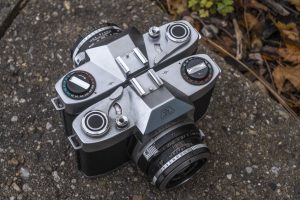
Despite the compact size of the camera, the top plate is logically laid out and doesn’t feel cluttered. On the left is the rewind knob with flip up handle and a film reminder dial. These cameras did not have a light meter, so setting the film speed is purely optional. Above the pentaprism is an accessory shoe for attaching a flash or perhaps some kind of clip on meter. To the right is the automatic resetting exposure counter, cable threaded shutter release button, and film advance lever.
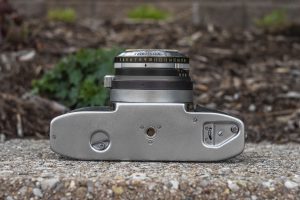
On the bottom is the rewind release button, a centrally located 1/4″ tripod socket, and a clever door lock and release. A slider has two positions, O for Open, and L for Lock. With the slider in the locked position, the chrome button next to it doesn’t do anything. Move it to the open position and press the button, and the door pops open. It’s not exactly rocket science, but works really well, and is far more elegant than solutions found on other cameras.
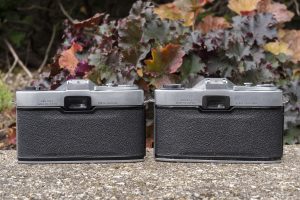
Keeping with the camera’s clean design, there’s not much to see on the back other than the serial number, inscriptions saying Made in Japan, Tokyo Kogaku, and the rectangular opening for the viewfinder’s eyepiece. It is interesting that both the Topcon PR and DeJur branded Dekon SR both have serial numbers in the range of 380xxx, and both mention Tokyo Kogaku on the back, suggesting that no effort was made to hide the identity of the DeJur version.
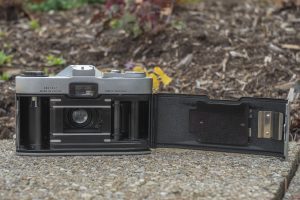
With the right hinged door opened, we see an ordinary looking 35mm film compartment. Film transports from left to right onto a single slotted and fixed take up spool. The spool rotates clockwise, which means the film rolls backwards of how it is rolled in the cassette, which is said to allow it to lay flatter when traveling across the film plane. The pressure plate on the door has a smooth painted finish with divots that help reduce resistance on the film. All of the light seals around the hinge and door channels are made from a velvet-like material, and unlike foam seals which were increasingly used in the 1960s, have not rotted away on either of these examples, suggesting they should still be doing a good job at protecting the film from light leaks.
The viewfinder is pretty sparse, at least, I think it is. With both of these cameras having inoperable shutters, I can’t get either mirror to drop so that light could enter the viewfinder. Neither the manuals for the Topcon PR or DeJur Dekon SR have an image showing what the viewfinder looks like, but from what I gather, the entire ground glass can be used for focusing with a Fresnel pattern surrounding a ground glass circle. I do not see any reference to either a split image or microprism focus aide.

Both the Topcon PR and DeJur Dekon SR are attractive and compact cameras that were built by a company who during their prime made excellent cameras. I have no doubt in my mind that when found in working condition, these cameras could make excellent images. The original Zeiss-Ikon Contaflex matches these cameras almost feature for feature with a fixed 45mm f/2.8 4-elememt lens, fixed pentaprism viewfinder, no metering, and a leaf shutter.
I think I’m gonna call it… When you go 0 for 3 on a particular camera and none of them work, it’s best to just admit defeat and move on. Perhaps one day, a fourth example will come my way and that one will work fine, and if that does happen, I’ll be sure to update this review, but I’m not going to keep looking. I’m not upset though, as I was still able to tell you the camera’s story and share with you some thoughts about it’s use. In fact, I’m glad I finally wrote this review as I can remove it from my “to review spreadsheet” and get to one of the other 174 cameras I have waiting to be reviewed.
Related Posts You Might Enjoy
External Links
http://camera-wiki.org/wiki/Topcon_PR_II
http://web.archive.org/web/20180727043815/http://www.camera.portraits.srv2.com/topconpr.htm (Archived)
https://www.rangefinderforum.com/classics/forum/messages/6899/8156.html?1165368314

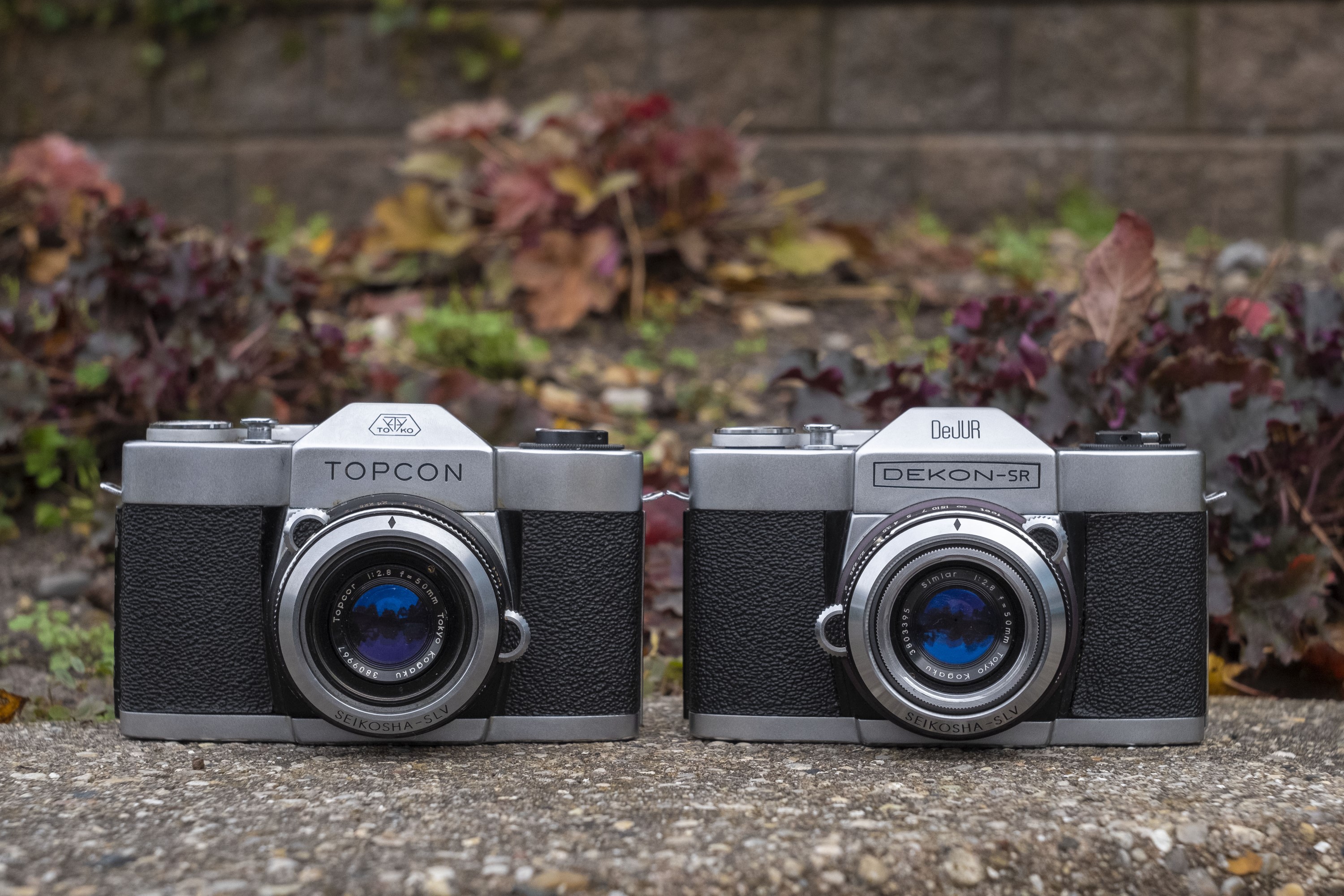
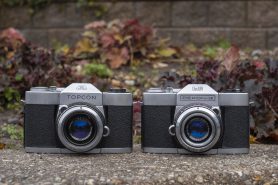
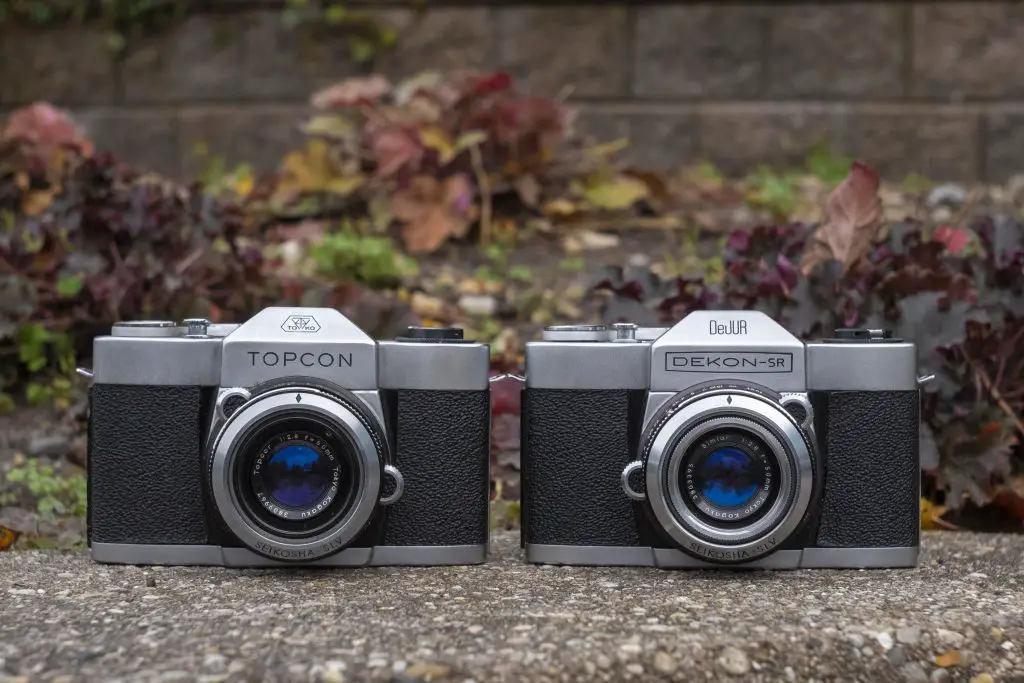
Don’t worry Mike, I also never learn and am obsessed with leaf shutter SLRs XD
I’m on my third Kowa SET-R, and of course none of them work.
Nice archeological dig! Thanks!
I just purchased one and received it today. I took it out of the box and it worked well for about three shots. Strangely, when I went to forward the shot, the forwarding knob became loose. I played around with it for a few minutes, but honestly don’t want to deal with it today.
In the meantime, I will move the film unto the Kowa SET-R. Believe it or not I purchased one last year and it works wonders. I am a fan of Kowa lens and had one adapted to LTM that I use with my Zorki 1.
I’ve come across 3 versions of either the Topcon or Dekon models and none have worked. Although I never had an issue with the wind lever, the shutters usually die on them. Even if they work for 1-2 shots, as soon as you fire the shutter, what little lube is left, will move around and get to somewhere it shouldn’t be and seize up the whole works.
I’ve seen Topcon and Pentax exam and scan equipment in several doctors’ offices.